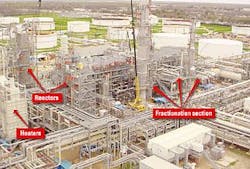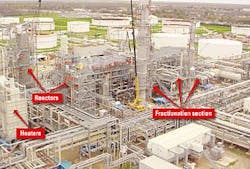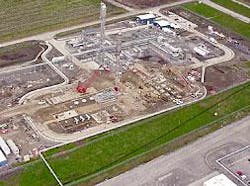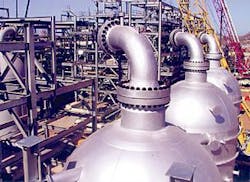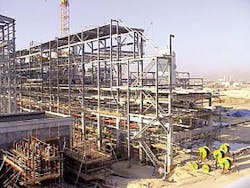Oil and natural gas engineering and construction contractors say that some downstream industry projects could be delayed due to economic and safety concerns arising from the US/Iraq armed conflict.
"Although the conflict with Iraq won't have much of an effect for clean fuels-oriented licensing and detailed engineering work," said Charles Cameron, director of business development for Axens SA in Paris "some construction will almost certainly be delayed for awhile, especially in the petrochemical industry."
Most refinery projects will move forward as refiners plan to meet upcoming US and European gasoline and on-road diesel standards.
However, petrochemical projects are likely to be delayed, he said. Basic petrochemical processes used to manufacture consumer goods such as autos, housing, and clothing, are at risk, so certain projects could be put on hold.
Weak demand for petrochemicals is another contributing factor. Last year, petrochemical manufacturers expected a recovery of demand by the second half of 2003.
null
Now, recovering demand is not expected until perhaps as late as 2006. Subdued demand continues in Malaysia, Taiwan, India, and the Middle East. Demand for petrochemicals is stronger in China where GDP continues to be above 6%, said Cameron.
On the gas processing side, the story is the same, according to Technip-Coflexip of Paris. "One would expect more gas projects due to higher gas prices," said Max Mountjoy, vice-president of marketing, Technip USA Corp., Houston, "but there is a bit of a disconnect. We expect activities to recover after decisionmakers shed some financial uncertainty currently surrounding the industry."
Due to the UN embargo of Iraq, much of that country's hydrocarbon- processing facilities are in disarray. The only possible supply of HP equipment for Iraq is the supply of portions of plants allowable under the UN controlled "Oil For Aid" program.
APS Engineering Co., Rome, delivered manifolds and gas separator vessels to Iraq as sanctioned under the UN program. The project, yet to be completed due to other suppliers' equipment delays, is the intended gas separation plant expansion at West Qurna, one of Iraq's largest oil fields. The 250 MMcfd gas plant expansion will include APS Engineering manifolds, basic engineering, and process design. The original expected completion was mid-2002, but the project has been put on indefinite hold.
Such equipment delays are foreseeable. Harvey Rosenfeld, vice-president of business development for ABB Lummus Global Inc., Houston, has no plans for cancellation of projects under way in Saudi Arabia, South America, China, or elsewhere. Still, he notes, some logistical disruptions and some withdrawal of supplier personnel could occur.
"The largest disturbance we currently face is in shipping. The US must use ships to send troops and munitions to the Middle East, ships that were previously reserved by commercial interests for equipment shipments. However, at this time we expect this to be manageable," Rosenfeld said.
The Worldwide Construction Report Survey, normally included after this article, will now be exclusively available on our website at Oil & Gas Journal Online (www.ogjonline.com).
Refining
Despite industry concerns, worldwide refiners report construction plans for new or expanded crude unit capacity of more than 1.3 million b/d. Of that capacity, 40% is expected to be on stream by yearend, with another 44% due in 2004.
According to the survey results, projects are under way for more than 2 million b/d of hydrotreating capacity, 1 million b/d of desulfurization capacity, 800,000 b/d of hydrocracking capacity, and 1,000 MMcfd of hydrogen production or recovery to support hydroprocessing.
Also, over 200,000 b/d of new FCC capacity is expected by the end of the year, with an additional 100,000 by end of year 2004. Over 300,000 b/d of new reforming capacity will be built by 2005.
Of particular note is the Consumers Cooperative Refinery Ltd., Regina, Sask., project. The extensive refinery upgrade is nearly completed. New unit capacities include 30,000 b/d crude distillation, 10,000 b/d vacuum distillation, 27,000 b/d catalytic hydrotreating, and 40 MMcfd of hydrogen production. An additional 14,000 b/d hydrotreating unit is expected to be completed by July 2004.
Murphy Oil Inc. has a 20,000 b/d crude distillation unit currently under construction Meraux, La., with an expected completion date of November 2003. Other units under construction at the refinery include a 44,000 b/d hydrocracker, a 12,000 b/d naphtha desulfurizer, and a 12,000 b/d reformer, all licensed by UOP LLC, Des Plaines, Ill.
Oman Refining Co., Mina Al-Fahal, Muscat, is implementing a diesel hydrodesulfurization project under contract to SK Engineering & Construction Co. Ltd., South Korea, said Gyan Pandey, the refinery's production and planning director.
A sulfur-recovery unit is included for the project. Additionally, a C5-C6 isomerization project and an associated naphtha hydrotreater and naphtha splitter revamp are in the engineering stage. Oman Refining Co. has commissioned UOP LLC to undertake a refinery wide revamp study for their future review, he said.
Abu Dhabi Oil Refining Co., Ruwais, has enlisted Technip-Coflexip SA to take the lead in a major refinery expansion. Three hydrotreaters, a reformer, and an isomerization unit are among the expansions under way in the $480 million project, which has a targeted completion of July 2005.
Technip-Coflexip also won the contract with Empresa Colombiana de Petroleos, Cartegena, Colombia, for basic design and project management of that refiner's planned $630 million expansion. After completion, Ecopetrol will have increased refinery capacity to 140,000 b/d from 75,000 b/d while complying with international fuel standards and environmental limitations.
Petrochemicals
In the petrochemical industry, OGJ's survey documents 5.6 million tpy of planned new ammonia capacity, 12.8 million tpy of new methanol capacity, and 7.8 million tpy of new polypropylene capacity.
Due to market conditions, some petrochemical companies are somewhat reluctant to allocate capital to ethylene production projects.
For example, Linde Engineering Division AG, Hoellriegelskreuth, Germany, reports two out of seven ethylene projects have been placed on hold. The first is the Dow Chemical Iberica SA 100,000 tpy ethylene project in Tarragona, Spain. The second is the Gazkomplektempex 340,000 tpy project in Novy Urengoy, Russia.
However, resolution of the Iraq and Venezuela situations is expected to bring down ethylene feedstock prices and encourage new capacity additions to meet expected ethylene demand of 43.5 tpy by 2006 (OGJ, Mar. 31, 2003, p. 42).
Currently, and barring further delays and cancellation, more than 23.3 tpy of new ethylene capacity is expected to be available by 2008.
Of this new capacity, 8.2 million tpy will come on stream by 2003, 5 million tpy by 2004, 6.4 million tpy by 2005, and 3.7 million tpy through 2008—mostly in China, Iran, and the US.
Of the six largest ethylene projects, three will be built in Iran. These include Marun Petrochemical Co.'s 1.1 million tpy complex in Bandar Imam, National Petrochemical Co.'s 1 million tpy complex in Bandar Assaluyeh, and the 1 million tpy Pars Petrochemical complex in Bandar Assaluyeh. The other three projects are the Pequiven SA 1 million tpy project to be built in Jose, Anzoategui, Venezuela, Saudi Basic Industries Corp.'s 1 million tpy plant in Al Jubail, Saudi Arabia, and Veba AG's 1 million tpy complex in Gelsenkirchen, Germany.
null
Polyethylene, widely used to manufacture various products from storage tanks to pipe coatings, will see an increased production capacity of 7.8 million tpy by 2006.
One polyethylene project of note is Eurochem Technologies Corp.'s methanol to olefins (MTO) complex to be located at Ibeju Lekki in Lagos State, Nigeria.
The MTO process, codeveloped by UOP Inc., and Norsk Hydro ASA, Oslo, Norway, will be part of a gas-to-polymers project built to produce 400,000 tpy of high-density polyethylene and an equal amount of polypropylene. According to UOP, Nigeria is a good candidate for the MTO project due to its vast reserves of gas and regional demand for polyolefin products. The project is expected to be completed in 2006.
Gas-to-liquids
The OGJ Construction Report counts less than 300,000 b/d of proposed GTL capacity to be built in the near future. Licensing companies continue to struggle to prove the technology as a viable solution to the problem of stranded gas. No plants were completed last year, despite some promising starts.
Syntroleum Corp., Tulsa, has yet to determine the location, size, and the source of gas to feed the proposed Talara basin, Peru, plant, and that project has been removed from the OGJ report.
null
Additionally, the Sweetwater GTL project on the Burrup peninsula of Western Australia officially has been suspended, although Syntroleum is working on a coal-to-liquids project in Australia.
The BP Alaska GTL plant in Nikiski, Alas., is not operating at capacity yet. The plant is working towards sustained start-up with a planned testing period of 12-18 months to prove up the compact reformer and convertor catalyst technologies.
Foster Wheeler, Berks, UK, has completed the FEED studies for Chevron Nigeria Ltd.'s Escravos project and Sasol/Qatar Petroleum's Ras Laffan project.
Technip-Coflexip won the EPC contract for the Ras Laffan complex, worth $700 million. The plant will use 330 MMcfd of gas from giant North field to produce 24,000 b/d of clean fuels, and is expected to be onstream in 2005.
Gas processing
Liquefied gas projects continue to be the big news in gas processing. Worldwide, more than 92 million tpy of new capacity is expected by 2010.
Malaysia and Trinidad and Tobago are expected to finish their projects this year to bring 6 million tons/day of LNG into the market. An additional 30 million tpd is forecast for 2004.
LNG regasification projects are plan- ned for the US, China, and Spain, most of which will be onstream in 2005.
ChevronTexaco applied for a license to build and operate a permanent concrete deepwater port off Louisiana to receive LNG shipments. The project, to be called Port Pelican, would include a receiving terminal, storage, and regasification facilities. The sales gas, about 800 MMcfd, would be sent into the existing pipeline network for delivery onshore. If built, the in-service date would be 2006.
In competition, EL Paso Global LNG also applied for a license to build an offshore LNG import terminal in the GOM. The EL Paso facility, called EP Energy Bridge, would be a floating mooring buoy that would allow LNG tankers to regasify their cargo at a top rate of 500 MMcfd. The gas would be sent ashore via an existing pipeline system. This facility could be available as early as 2004.
Storage capacity projects are planned for existing facilities in coastal areas. In particular, CMS will construct a 3 bcf storage tank at the Lake Charles, La., facility. Storage capacity at that location will increase to 9 bcf from 6 bcf, and send-out capacity will increase to 1.2 bcfd from 630 MMcfd. The project will permit unloading of two ships simultaneously at the terminal for a maximum of 175 ships to be unloaded per year, up from 62.
Sulfur
Worldwide, sulfur recovery unit projects at refining and gas processing facilities indicate an additional 22,000 tpd capacity will be available by 2006.
null
In 2002, sulfur recovery design capacity was 166,519.6 tpd with actual production of 80,669.4 tpd, a utilization rate of 48%.
The on-rack piping installation is in progress for the third train of the Ras Laffan LNG Co. Ltd. project in Qatar. When completed in 2005, the expansion will increase production by 5 million tonnes/year. A fourth train will be built to further increase capacity by 5 million tonnes/year. Photo courtesy of Chiyoda Corp., Yokohama, Japan.
There are early indications that storage of unmarketable sulfur may become a problem. Tengizchevroil recently was fined $7 million by a court in Kazakhstan for alleged environmental damage caused by storing millions of tonnes of sulfur at its Tengiz field.
Yet, new or expanded sulfur recovery units continue to be needed to support new clean fuels regulations or to treat gas streams.
Aramco Overseas Co., Saudi Arabia, plans new capacity to upgrade the Berri gas plant to process 370 MMcfd of gas. One expansion and two new units are planned and, at the project's completion in 2004, total production will be 3,300 tpd.
Societe Anonyme Marocaine de L'Industrie du Raffinage in Mohammedia, Morocco, plans to increase refinery capacity to 160,000 b/d, up from 125,000 b/d. The refinery expansion includes two new sulfur-recovery units at 250 tpd each.
In the US, Murphy Oil plans to increase sulfur recovery capacity at two refineries. At 30 tpd unit is under construction and a 10 tpd expansion is planned for the Superior, Wis., refinery. A new 120 tpd unit will be built at Murphy's Meraux, La., complex.
Pipelines
In pipeline updates, construction of China's West-East gas pipeline is well along (OGJ, Mar. 17, 2003, p. 68). The pipeline will stretch from Xinjian to Shanghai, more than 2,300 miles. Construction began on the pipeline in 2002 and is now 40% complete.
The BP/Sonatrach pipeline in Algeria is under construction as well, with an expected completion date of second quarter 2004. The gas pipeline will run from In Salah to Hassi R'Mel, 280 miles of 24 and 38-in. pipe, to move 870 MMcfd.
Other major pipeline projects are the Malvinas to Lima, Peru, 440-mile gas line and the 340-mile Malvinas to Pisco products pipeline, both to be operated by Transportation de Gas des Peru, and the 312-mile Eastern Ecuador pipeline for Oleoducto de Crudos Ecuador SA pipeline. The expected completion for those pipelines is 2004.
Pemex has two major pipelines under construction. The first, a 635-mile, 24-in. diameter pipeline, from Nuevo Teapa to Cadereyta, will transport crude oil, while the second, a 168-mile, 12-in., products pipeline will be built from Cadereyta to Matamoros.
Completion dates were not reported.
Gazprom's Blue Stream pipeline is in service. The deep, offshore pipeline connecting Russia to Turkey under the Black Sea came onstream with a pricetag of $3.5 billion. Blue Stream is expected to move 2 bcm of gas in 2003 and will ramp up to 16 bcm by 2008.
And finally, still speaking of war-related delays, BP PLC ran into post-war problems while the gas pipeline in Viet Nam was under construction. Live grenades, artillery shells, and land mines left over from the Viet Nam war era obstructed BP's development of the 248-mile gas pipeline intended to connect gas fields with power plants. Much of the ordnance was live, but it was removed without mishap.
OGJ subscribers can download free of charge the Worldwide Construction Report survey tables via links under the Current OGJ Issue/Special Report heading at OGJ Online's home page at www.ogjonline.com or at http://ogj.pennnet. com/survey/survey.cfm?Section =Survey.
Click here to view the Worldwide Construction Report, 21 pages, in PDF.
Click here to view Pipeline Construction data (6 pages) in pdf.
